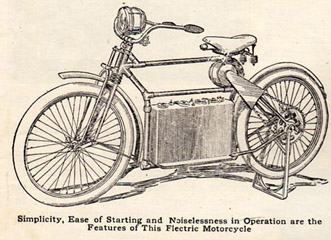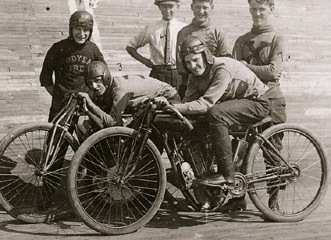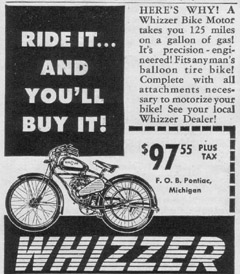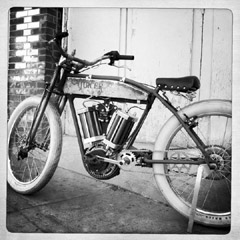DAWN OF THE MOTORBICYCLE
As can be inferred from the word, "motorcycle" or "motorbike"
these vehicles have their roots in bicycle technology. In fact, many
of the famous motorcycle manufacturers of yesteryear, such as Arial,
Indian (Hendee Manufacturing), and Yale, began as strictly bicycle
makers. The addition of motors to bicycle frames in the late 1800's
was a natural progression. The first engines were steam, but gas and
electric motors were not far behind. These vehicles retained their
pedals and can be considered early examples of hybrid vehicles.
EVOLUTION INTO MOTORCYCLES
After the turn of the century, heavier-weight frames were made to
specifically address the space/strength requirements of larger, more
powerful engines. These "loop-frames" cradled the power-plant
in a U-shaped loop, shifting the pedals further to the rear. This
look of bike is most closely associated with the board-track racing
era. By mid-century, motorbikes had lost their pedals and pretty much
resembled classic-style cruisers of today. Without pedals they were
now true motorcycles. If you still wanted a motorbicycle, from 1939
on you could get a kit from Whizzer that would bolt on to your bicycle.
As far as gas powered motorbicycles go, inexpensive "clip on"
motors are still where the scene is today.
EBIKES
With one glaring exception, electric bicycle patents reveal a parallel
history between e-bikes and their gas counterparts. Today, e-bikes
typically use hub motors paired with touring or mountain bike frames.
The electric motorcycle has enjoyed a great resurgence in America
and the fastest models are currently collecting racing trophies due
to their smooth acceleration and powerful low-end torque. These motorcycles
are generally "sport bikes" with full fairings, ridden in
the prone position. But what if you want an electric cruiser? Since
early last century, the e-cruiser has been a rare bird indeed.
JUICER FILLS THE GAP
Here at Juicer, we are picking up where history left off. Unlike the
e-bike and e-motorcycle manufacturers of today, we do not attempt
to hide the machinery that powers our vehicles. Instead, like the
makers of yesteryear, we strive to find the beauty in those materials
and show them. And like the designers of modern gas-powered cruisers,
we look to the past for our design cues. While this gives the Juicer
the look of an exotic antique bike, maintaining one is quite a bit
easier. This is because apart from the metalwork we do in-house, there
are no exotic parts in a Juicer emotorbicycle. All the rest of the
components are readily available off-the-shelf which ensures that
your Juicer will remain roadworthy mile after mile, year after year.
So today Juicer emotorbicyles stand poised to fill the gap between
the slow, upright ebikes and the fast sport emotorcycles, with a quick,
stylish, and economical alternative to the gas-powered bikes that
came before.
|
1911 Popular
Science article
|







